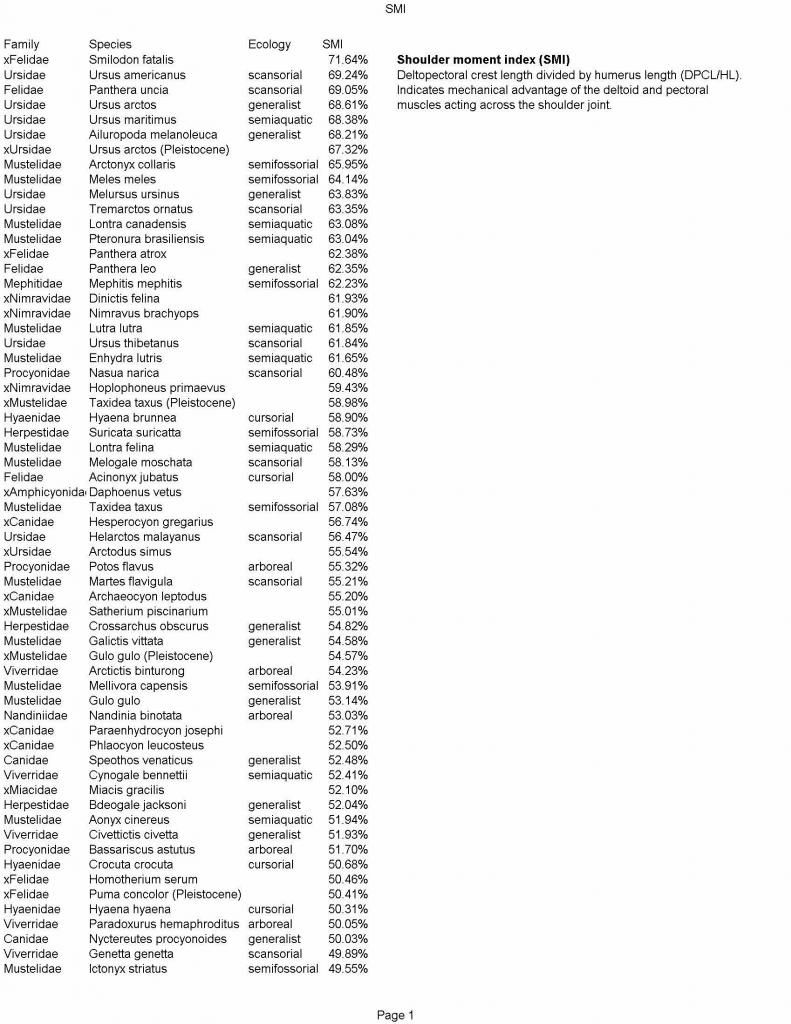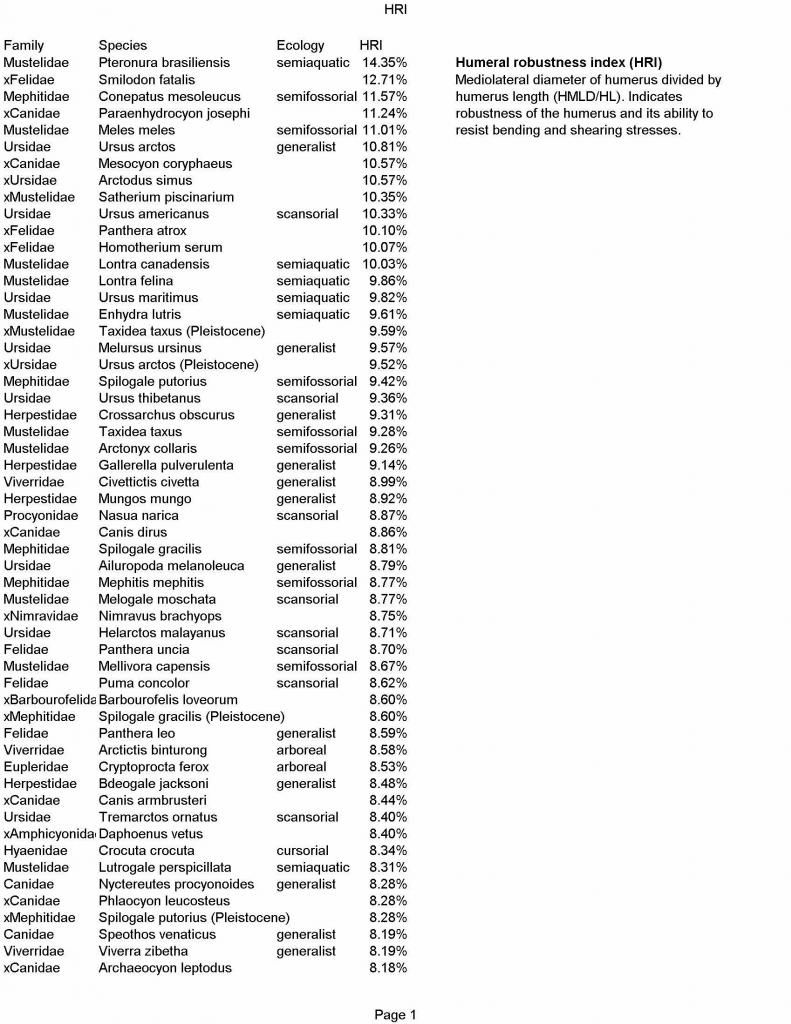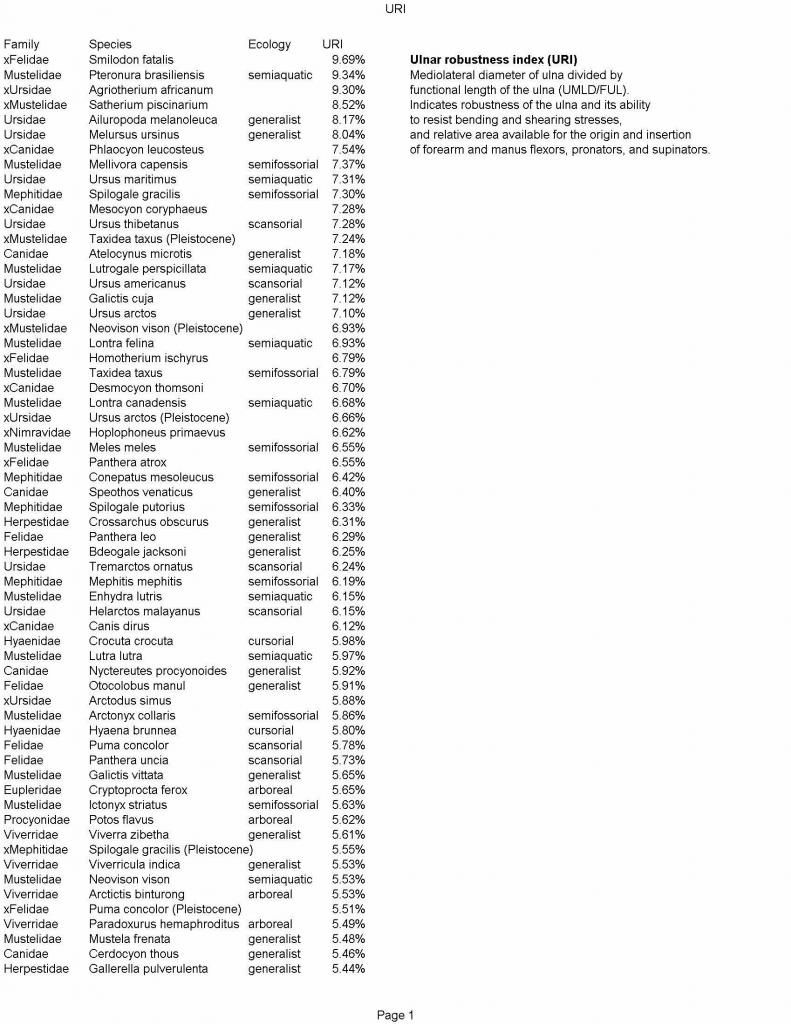|
|
Post by creature386 on Jan 2, 2015 15:54:59 GMT 5
Plants and small animals make up a large portion of grizzly bear diet, so I’m not sure whether an abundance of giant prey would have any notable effect at all. Possible that it was actually smaller and less macrophagous than today, due to being suppressed by bigger, more carnivorous bears and competing with giant cats in its predatory niche. That’s mere speculation of course. One could argue that it would adapt to a carnivorous lifestyle because plants are not as easily accessible when it is that cold. |
|
|
|
Post by malikc6 on Jan 2, 2015 17:19:31 GMT 5
I give it to the bear here, but the cat just needs to sink it's fangs into the bear's throat and thats it. But more likely than not, I feel the bear would simply overpower the cat or wear it out due to having more stamina. I also am aware that their teeth broke quite easily. I know that they are more durable than made out to be, but I'm sure multiple paw swipes to the cat's head would break those fangs, leaving the cat to rely on its grappling abilities, and it likely won't win from there on. It's biggest weapons are its long saber like teeth. Without it, it has very little chance, and their bite force is actually much less than that of modern day cats like tigers and lions.
Once more, the cat would have to get the bear into a position where it could get a decent bite onto the bear's throat to win. If it can't, then it loses against the bigger, heavier, and stronger bear. Grizzly 7/10.
|
|
|
|
Post by theropod on Jan 2, 2015 19:02:10 GMT 5
creature386: yup, one could. But it’s a complex question that can’t be answered so straightforwardly. Extant grizzlies are by far the largest carnivores in their ecosystem, they have little to fear from other predators. A modern grizzly preferring meat over other food is one thing, a pleistocene one is another thing, and a pleistocene one doing so with the degree of success that would allow it to super-size against more specialized predators is yet another. malikc6: It’s due to these teeth that it won’t need a strong bite force, its bite is still a more potent weapon than that of an extant cat because it can cause deep slashing wounds instead of punctures. But of course multiple paw swipes to the head would be devastating. I’d imagine if the bear managed to repeatedly swipe it in the head with full power, its teeth breaking would be the least of its worries.
|
|
|
|
Post by malikc6 on Jan 3, 2015 2:18:30 GMT 5
I know that it doesn't need a strong bite force, but I feel like it would still be quite hard to manipulate the larger bear into a position where it could do that. Now at parity, I'm certain it could happen (would be pretty tough still), but at natural weights (or max weights), the bear takes this more often than not.
|
|
|
|
Post by Vodmeister on Jan 3, 2015 2:49:54 GMT 5
I know that it doesn't need a strong bite force, but I feel like it would still be quite hard to manipulate the larger bear into a position where it could do that. Now at parity, I'm certain it could happen (would be pretty tough still), but at natural weights (or max weights), the bear takes this more often than not. At natural weights these animals are fairly closely matched. Max weights is unfair because of our very limited sample size on prehistoric animals. I mean, if you were to plot a large sample of bears onto a chart and study their natural size in the wild, I'll willingly bet that those grizzlies that top 454 kg (1000 lbs) would make up 0.13% of the population at most, eg. the deviation furthest to the right (+3σ).  You'd need a smilodon fatalis population sample size 769.23 in order to overcome the odds of actually finding a specimen who falls in that particular deviation. We don't have anywhere near that many fossils of fatalis. |
|
|
|
Post by Vodmeister on Jan 3, 2015 3:03:24 GMT 5
I give it to the bear here, but the cat just needs to sink it's fangs into the bear's throat and thats it. But more likely than not, I feel the bear would simply overpower the cat or wear it out due to having more stamina. According to a post by Black Ice on CF, smilodon was certainly not weaker than a grizzly bear. Quite the opposite, actually. Shoulder moment index (SMI):Animals with larger SMI figure will have stronger shoulder and chest muscles.  Smilodon fatalis: 71.64% Ursus Arctos: 68.61% Humeral Robusty Index (HRI):Robust forelimb bones protect the animal from violent stresses during grappling, aka superior durability.  Smilodon fatalis: 12.71% Ursus Arctos: 10.81% and lastly; Ulna Robusticity Index (URI): Smilodon fatalis: 9.69% Ursus Arctos: 7.10% I was especially impressed by how much higher Smilodon fatalis scored than Ursus arctos here, 9.69% vs 7.10% is quite the difference. This means that the smilodon's ulnar is 36.5% more robust than that of the bear, assuming equal in size. |
|
|
|
Post by mechafire on Jan 3, 2015 4:10:24 GMT 5
I give it to the bear here, but the cat just needs to sink it's fangs into the bear's throat and thats it. But more likely than not, I feel the bear would simply overpower the cat or wear it out due to having more stamina. According to a post by Black Ice on CF, smilodon was certainly not weaker than a grizzly bear. Quite the opposite, actually. Shoulder moment index (SMI):Animals with larger SMI figure will have stronger shoulder and chest muscles.  Smilodon fatalis: 71.64% Ursus Arctos: 68.61% Humeral Robusty Index (HRI):Robust forelimb bones protect the animal from violent stresses during grappling, aka superior durability.  Smilodon fatalis: 12.71% Ursus Arctos: 10.81% and lastly; Ulna Robusticity Index (URI): Smilodon fatalis: 9.69% Ursus Arctos: 7.10% I was especially impressed by how much higher Smilodon fatalis scored than Ursus arctos here, 9.69% vs 7.10% is quite the difference. This means that the smilodon's ulnar is 36.5% more robust than that of the bear, assuming equal in size. where are those images from? |
|
|
|
Post by theropod on Jan 3, 2015 4:39:57 GMT 5
I know that it doesn't need a strong bite force, but I feel like it would still be quite hard to manipulate the larger bear into a position where it could do that. Now at parity, I'm certain it could happen (would be pretty tough still), but at natural weights (or max weights), the bear takes this more often than not. What I mean is that it would by no means have an easier time if it had a larger bite force, or regular feline dentition. If anything, that would make it more difficult to fatally injure the bear. |
|
|
|
Post by 0ldgrizz on Jan 3, 2015 6:26:48 GMT 5
Pound for pound, perhaps Smilodon was as strong as a grizzly. But, we are not talking about grizzlies feeding on ground squirrels, pine nuts, and moths. There were Mammoths and Mastodons, giant camels and several species of huge bison, wild horses, and the list goes on. There was no shortage of meat. I believe that the grizzly was nothing less than coastal brown bear size. In fact, with such a heavy population of prey animals and predators leaving carcasses all over the environment, it is possible that many grizzlies had no need for hibernation.
Pioneers of the American west discovered that the grizzly was a highly aggressive predator. Read the journals of Lewis and Clark. The highly aggressive nature of the grizzly has greatly diminished due to the invention of the breech-load rifle in 1848. But, the Pleistocene grizzly was not a shy bear hiding in the shadows. He was out there standing his ground. Note: I have yet to see any data on the size of Pleistocene grizzly fossils. |
|
|
|
Post by theropod on Jan 3, 2015 6:50:46 GMT 5
Pound for pound, perhaps Smilodon was as strong as a grizzly. But, we are not talking about grizzlies feeding on ground squirrels, pine nuts, and moths. There were Mammoths and Mastodons, giant camels and several species of huge bison, wild horses, and the list goes on. There was no shortage of meat. I believe that the grizzly was nothing less than coastal brown bear size. In fact, with such a heavy population of prey animals and predators leaving carcasses all over the environment, it is possible that many grizzlies had no need for hibernation.
Pioneers of the American west discovered that the grizzly was a highly aggressive predator. Read the journals of Lewis and Clark. The highly aggressive nature of the grizzly has greatly diminished due to the invention of the breech-load rifle in 1848. But, the Pleistocene grizzly was not a shy bear hiding in the shadows. He was out there standing his ground. Note: I have yet to see any data on the size of Pleistocene grizzly fossils. So in other words, you are just guessing that pleistocene grizzlies were larger than extant ones, without the slightest evidence. Have you even considered that this might not be the case? Wolf reintroduction in yellowstone has drastically reduced the pack size of coyotes andd their impact on prey (http://m.bioscience.oxfordjournals.org/content/53/4/330.full#ref-6). What if the same applies to the presence of short-faced bears and the body size of grizzlies during the pleistocene? It's possible that pleistocene grizzlies were larger than extant ones. It's just as possible that they were smaller. Without clear evidence, how can we assume either? |
|
|
|
Post by 0ldgrizz on Jan 3, 2015 8:00:01 GMT 5
In Siberia, home of the Amur tiger, the average grizzly is larger than those inland grizzlies of North America. And no I'm not just guessing. I'm looking at the food resources. The key to grizzly size is food availability. My posts are pretty much self explanatory; if you would bother to read them rather than merely trying to start a fight. With a land lush in natural resources including mega-fauna, those Pleistocene grizzlies were probably eating better than the coastal bears of today. Note: wolf introduction improved the lives of the grizzlies; more carcasses to take over. |
|
|
|
Post by Vodmeister on Jan 3, 2015 8:09:53 GMT 5
Pound for pound, perhaps Smilodon was as strong as a grizzly. But, we are not talking about grizzlies feeding on ground squirrels, pine nuts, and moths. There were Mammoths and Mastodons, giant camels and several species of huge bison, wild horses, and the list goes on. There was no shortage of meat. I believe that the grizzly was nothing less than coastal brown bear size. In fact, with such a heavy population of prey animals and predators leaving carcasses all over the environment, it is possible that many grizzlies had no need for hibernation.
Pioneers of the American west discovered that the grizzly was a highly aggressive predator. Read the journals of Lewis and Clark. The highly aggressive nature of the grizzly has greatly diminished due to the invention of the breech-load rifle in 1848. But, the Pleistocene grizzly was not a shy bear hiding in the shadows. He was out there standing his ground. Note: I have yet to see any data on the size of Pleistocene grizzly fossils. So in other words, you are just guessing that pleistocene grizzlies were larger than extant ones, without the slightest evidence. Have you even considered that this might not be the case? Wolf reintroduction in yellowstone has drastically reduced the pack size of coyotes andd their impact on prey (http://m.bioscience.oxfordjournals.org/content/53/4/330.full#ref-6). What if the same applies to the presence of short-faced bears and the body size of grizzlies during the pleistocene? Coyotes are generally dominated by wolves in both carcass disputes and territorial conflict. Wolves don't dominate grizzlies however, and grizzlies occasionally scavenge wolf kills. I think that what 0ldgrizzly is trying to say, is that because wolves tend to leave a lot of dead carcasses behind, grizzlies will likely grow larger in that area because meat is more readily available. That's my interpretation (not saying I fully agree with it, although he probably has a point). There was some data that suggests that Smilodon might be even stronger, but none of that data is conclusive. We can only guess, my intuition suspects that a 280 kg smilodon fatalis is probably just about as strong as a 280 kg grizzly bear. Of course, there's more than one definition to "strength": Pulling strength, pushing strength, leverage, etc... |
|
|
|
Post by Vodmeister on Jan 3, 2015 8:12:52 GMT 5
|
|
|
|
Post by malikc6 on Jan 3, 2015 8:37:10 GMT 5
Off topic question, has there even been a recorded instance of a large coyote pack killing a wolf, cougar, bear, or something bigger?
|
|
|
|
Post by 0ldgrizz on Jan 3, 2015 10:30:54 GMT 5
With the food resources of Pleistocene North America, there is little doubt in my mind that the grizzly was double the weight of a 450 pound Smilodon fatalis. It is inconceivable that the grizzly would not take full advantage of his resources. The largest big cat of Pleistocene North America was Panthera atrox which averaged roughly 560 pounds. Even he was no match for the much heavier grizzly. The Ussuri brown bear averages roughly 590 pounds and his food resources are poor in comparison to that of the late Ice Age North America.
|
|